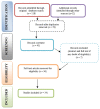The Use of Laser Energy for Etching Enamel Surfaces in Dentistry-A Scoping Review
- PMID: 35329440
- PMCID: PMC8949169
- DOI: 10.3390/ma15061988
The Use of Laser Energy for Etching Enamel Surfaces in Dentistry-A Scoping Review
Abstract
Background: In dental practice, different situations require etching the enamel layer. Acid etching, the present golden standard, may be replaced by other methods, such as laser etching. The main focus of our scoping review is to assess the existent literature regarding the effectiveness of different types of lasers, to identify the main aspects studied so far, and to understand where new search strategies are needed.
Methods: The search was conducted in several databases focusing on the laser etching of human definitive enamel. We included English language articles published between January 2000 and December 2021.
Results: The 34 articles reviewed showed that hard lasers, Er:YAG, Er,Cr:YAG, may represent an alternative etching method on enamel surfaces. They create a fractured, irregular surface and open dentin tubules, highly suitable for adhesion but with a lower risk of cavity formation. Nd:YAG, CO2, and Diode lasers do not help in creating sufficient shear bond strength. There is, however, evidence suggesting that microcracks in the enamel layer may appear after thermomechanical ablation using laser energy.
Conclusions: While the use of acid etching is still successfully used for enamel conditioning, some researchers have emphasized the role played by saliva in the enamel-remineralization process a few days after the procedure. In this context, laser energy can be used, especially for bonding ceramic brackets in the case of orthodontic treatments. However, as thermomechanical ablation can generate microcracks, further research is required in order to establish clear findings concerning the use of laser energy on enamel etching.
Keywords: enamel surface; etch; laser treatment.
Conflict of interest statement
The authors declare no conflict of interest.
Figures
Similar articles
-
Assessment of microcracks and shear bond strength after debonding orthodontic ceramic brackets on enamel priorly etched by different Er,Cr:YSGG and Er:YAG laser settings without acid application: An in vitro study.Int Orthod. 2019 Dec;17(4):744-757. doi: 10.1016/j.ortho.2019.08.019. Epub 2019 Sep 19. Int Orthod. 2019. PMID: 31543426
-
Differences in bonding to acid-etched or Er:YAG-laser-treated enamel and dentin surfaces.J Prosthet Dent. 2000 Sep;84(3):280-8. doi: 10.1067/mpr.2000.108600. J Prosthet Dent. 2000. PMID: 11005900
-
Effect of erbium family laser etching on shear bond strength of enamel surfaces: A meta-analysis-PRISMA.Medicine (Baltimore). 2022 Oct 7;101(40):e30990. doi: 10.1097/MD.0000000000030990. Medicine (Baltimore). 2022. PMID: 36221405 Free PMC article.
-
Effects of different types of laser etching versus phosphoric acid etching on shear bond strength of metal brackets to human enamel: A systematic review and meta-analysis of in vitro studies.Int Orthod. 2020 Dec;18(4):673-683. doi: 10.1016/j.ortho.2020.10.001. Epub 2020 Nov 2. Int Orthod. 2020. PMID: 33144060
-
Effects of femtosecond laser on hard dental tissues: A scoping review.Lasers Med Sci. 2024 Nov 20;39(1):286. doi: 10.1007/s10103-024-04225-6. Lasers Med Sci. 2024. PMID: 39567415
Cited by
-
Er:YAG Laser in QSP Modality for Treatment of Indirect Adhesive Restoration Build-Up: Surface Roughness Analysis and Morphology Assessment by Environmental Scanning Electron Microscopy (ESEM).Dent J (Basel). 2025 May 21;13(5):223. doi: 10.3390/dj13050223. Dent J (Basel). 2025. PMID: 40422643 Free PMC article.
-
The effect of Er:YAG and Nd:YAG lasers and total-etch and universal adhesives on composite resin restoration microleakage.J Clin Exp Dent. 2025 May 1;17(5):e535-e541. doi: 10.4317/jced.62641. eCollection 2025 May. J Clin Exp Dent. 2025. PMID: 40485968 Free PMC article.
-
The role of laser irradiation in dental therapy during the SARS-CoV-2 pandemic.J Dent Sci. 2022 Oct;17(4):1846-1847. doi: 10.1016/j.jds.2022.05.017. Epub 2022 May 30. J Dent Sci. 2022. PMID: 35669091 Free PMC article. No abstract available.
-
Shear Bond Strength of Ceramic Brackets on Enamel Conditioned With CO2 Laser.Cureus. 2024 Oct 31;16(10):e72761. doi: 10.7759/cureus.72761. eCollection 2024 Oct. Cureus. 2024. PMID: 39618621 Free PMC article.
-
Influence of Different Enamel Pretreatment on Bond Strength of Fissure Sealant.Acta Stomatol Croat. 2024 Dec;58(4):339-347. doi: 10.15644/asc58/4/3. Acta Stomatol Croat. 2024. PMID: 39925690 Free PMC article.
References
-
- Romanos G.E. Advanced Laser Surgery in Dentistry. Wiley Blackell; Hoboken, NJ, USA: 2021. Laser Fundamental Principles; pp. 3–11.
-
- Miserendino L.J., Pick R.M. Lasers in Dentistry. Quintessence Publishing Co., Inc.; Singapore: 1995. Current Applications of Lasers in Dentistry; pp. 126–128.
Publication types
LinkOut - more resources
Full Text Sources



